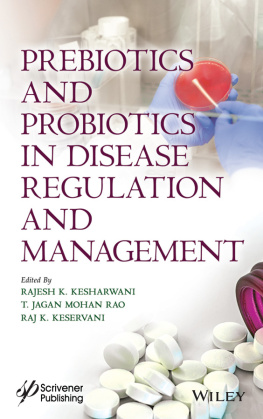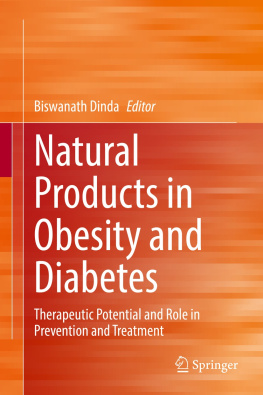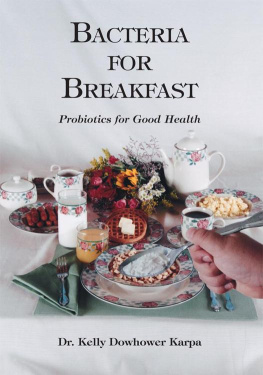
Scrivener Publishing
100 Cummings Center, Suite 541J
Beverly, MA 01915-6106
Publishers at Scrivener
Martin Scrivener ()
Phillip Carmical ()
Prebiotics and Probiotics in Disease Regulation and Management
Edited by
Rajesh K. Kesharwani
Tingirikari Jagan Mohan Rao
and
Raj K. Keservani

This edition first published 2022 by John Wiley & Sons, Inc., 111 River Street, Hoboken, NJ 07030, USA and Scrivener Publishing LLC, 100 Cummings Center, Suite 541J, Beverly, MA 01915, USA
2022 Scrivener Publishing LLC
For more information about Scrivener publications please visit www.scrivenerpublishing.com.
All rights reserved. No part of this publication may be reproduced, stored in a retrieval system, or transmitted, in any form or by any means, electronic, mechanical, photocopying, recording, or otherwise, except as permitted by law. Advice on how to obtain permission to reuse material from this title is available at http://www.wiley.com/go/permissions.
Wiley Global Headquarters
111 River Street, Hoboken, NJ 07030, USA
For details of our global editorial offices, customer services, and more information about Wiley products visit us at www.wiley.com.
Limit of Liability/Disclaimer of Warranty
While the publisher and authors have used their best efforts in preparing this work, they make no representations or warranties with respect to the accuracy or completeness of the contents of this work and specifically disclaim all warranties, including without limitation any implied warranties of merchantability or fitness for a particular purpose. No warranty may be created or extended by sales representatives, written sales materials, or promotional statements for this work. The fact that an organization, website, or product is referred to in this work as a citation and/or potential source of further information does not mean that the publisher and authors endorse the information or services the organization, website, or product may provide or recommendations it may make. This work is sold with the understanding that the publisher is not engaged in rendering professional services. The advice and strategies contained herein may not be suitable for your situation. You should consult with a specialist where appropriate. Neither the publisher nor authors shall be liable for any loss of profit or any other commercial damages, including but not limited to special, incidental, consequential, or other damages. Further, readers should be aware that websites listed in this work may have changed or disappeared between when this work was written and when it is read.
Library of Congress Cataloging-in-Publication Data
ISBN 978-1-394-16627-5
Cover image: Pixabay.Com
Cover design by Russell Richardson
Set in size of 11pt and Minion Pro by Manila Typesetting Company, Makati, Philippines
Printed in the USA
10 9 8 7 6 5 4 3 2 1
Preface
The demand for biobased products is increasing enormously, among which are prebiotic oligosaccharides and probiotics, which occupy a major share of the food industry. Even though the majority of agro waste is currently being used for the production of 2G biofuels, agro waste such as citrus peel, sugar beet pulp, copra meal, and wheat husk can be considered for the pro-duction of prebiotic oligosaccharides. Prebiotics are dietary fibers which are selectively fermented by the microbes present in the gut and promote the growth of beneficial bacteria in the intestine and regulate the growth of harmful bacteria. Thus, help in maintaining gut homeostasis.
This book highlights the importance of nutraceuticals (prebiotics, and probiotics) in maintaining gut homeostasis, prevention and treatment of gut related disorders, as anti-cancer agent, immune-modulatory agent and in treatment of metabolic disorders. This book brings out the current challenges involved in formulation and development of nutraceuticals, together with the application of nanotechnology and bioinformatics-based approaches to study the effect of nutraceuticals on oral health, and gut microflora in a very precise way.
This book will be very informative not only to those in the scientific community working in various fields associated with disease prevention and treatment in the medical, biopharmaceutical and health sectors; but also as a resource to update budding researchers on the current use of pre-biotics and probiotics for the regulation, prevention and management of diseases.
We express our heartfelt appreciation to all the authors on behalf of the entire editorial board and the publisher. It was with your kind co-opera-tion, enthusiasm, and spirit of the authors we could have make this book published. We thank all the authors for considering our request and con-tributed significantly by sharing their knowledge and expertise in the developing the content of this book. It would be not appropriate if I fail to mention the tireless efforts of Martin Scrivener, and Linda Mohr (Editorial Assistant) of Scrivener Publication for making this book within a short time span. We dream of tremendous citations for your book chapters in near future. We hope that the co-operation of authors will continue in future too.
Editors
Rajesh K. Kesharwani
Tingirikari Jagan Mohan Rao
Raj K. Keservani
July 2022
Role of Probiotics in Treatment of Gut-Related Diseases
Kunal Kumar and Rajani Sharma
Amity Institute of Biotechnology, Amity University Jharkhand, Ranchi, India
Abstract
The living world is well invaded by microbes. Some impart beneficial roles, while others are harmful. The human body also has a number of symbiotic microbes that are beneficial in metabolic activities. Such microbes are categorized under probiotics. Probiotics have a natural mechanism to check the growth of pathogens and favors the growth of essential microbes. Such microbes are involved in major metabolic responses and utilize the residues as nutrition. They are also involved in the absorption of essential minerals from the intestine, repairing epithelial cells, boosting the immune system of our gut environment, and takes part in the treatment of major gastrointestinal diseases. Fermented foods are a natural source of probiotics. With such significance nowadays, it is also available commercially. The chapter has reflected the beneficial effect of probiotics in gut-related diseases.
Keywords: Probiotics, gastrointestinal diseases, inhibit pathogen, immune booster
1.1 Introduction
Microbes are omnipotent. They have adapted even to the adverse conditions. They can survive in hot springs as well as in the Arctic Ocean [1]. Microbes have significance in various life effecting metabolic activities. They have both beneficial and harmful effect on other living as well as the non-living worlds. They are well involved in the demineralization of soil to the recycling of nutrition. Microbes also have a significant role in the human body [2]. Few relations are even life taking and other play a central role in healthy living. These microbiomes may include archaea, bacterial, viruses, and even eukaryotes. The microbiomes are also involved in physiological regulations [3]. A significant role of microbes was seen in the gut of humans. It can survive even under adverse condition like in the gallbladder, which consists of antimicrobial activity of gastric juice [4]. They also cast a symbiotic relationship with the gut microenvironment. In the 19th century, a special categorization of microbes was done which has a beneficial role in human health. Such microbes were termed as probiotics [5]. Ferdinand Vergin was the first to coin the term probiotic in 1954, which is derived from the Greek word meaning for life. He mentioned probiotics as useful organisms and depicted their nature in his book Anti-und Probiotika [6]. In 1995, Gibson and Roberfroid consider probiotics as non-digested food components, which support the growth of microbes that maintain the health of the gastrointestinal tract [7]. Its usefulness was also supported by Fuller in 1989, Guarner and Schaafsma in 1998 [8, 9]. Later in the year 1965 Lilly and Stillwell defined probiotics as a growth promoter of other microorganisms. Few of the microbes promote the growth of probiotics by fermenting the non-digested food and serving the product as nutrition for them. Such organisms are known as Prebiotic [10]. The chapter aims to put together the mechanism of probiotics in serving gut diseases.
Next page





